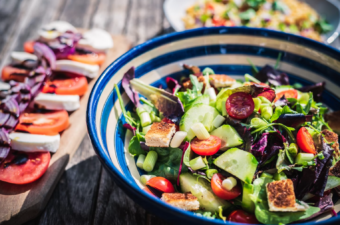 My kid is hell-bent on healthy eating. No more shawarma or falafel sandwiches she says, and she’s had it with high school cafeteria hummus here in Amman, Jordan. She’s also insistent on sustainable packaging (the little green prophet didn’t fall far from the tree), so cling-film wrapped leftovers don’t make it onto her lunch menu. Serendipitous that I just discovered Mason jar salads.
My kid is hell-bent on healthy eating. No more shawarma or falafel sandwiches she says, and she’s had it with high school cafeteria hummus here in Amman, Jordan. She’s also insistent on sustainable packaging (the little green prophet didn’t fall far from the tree), so cling-film wrapped leftovers don’t make it onto her lunch menu. Serendipitous that I just discovered Mason jar salads.
The glass jar salad trend is currently raging on Pinterest with hundreds of free recipes floating elsewhere online. These perfectly portable (and recyclable!) containers never spill and are ideal for night-before prep, so you can just grab-and-go the next morning. The jars’ ability to hold strategically layered fruit, grains, veggies and dressing without creating a soggy mess underpins their popularity. Making them is simple, and an ideal way to use leftovers.
You’ve seen these delicious eco-meals for sale at hipster food shops. Here are the dance steps to making your own at home:
- Start with a wide-mouthed Mason jar. You can buy them in a variety of sizes at home goods and hardware stores. IKEA even sells them.
- The first layer of the Mason jar salad is always the dressing. (Alternatively, add dressing last, stored in a nifty paper “cup”. Take a 6 inch square of parchment or wax paper, cover the top of the food-filled jar, make a dent (or bowl) in the center and pour in your dressing. Cap the jar tightly – trim excess paper – and the dressing is segregated until chow time.)
- The second layer creates a barrier between the dressing and delicate, absorbent ingredients such as leafy greens, tomatoes, rice, and pasta. Use hearty vegetables that would do well in a marinade: tomatoes, cucumbers, onion, broccoli, cauliflower, asparagus, celery, carrots, and peppers are all good choices.
- Softer foods like cooked beans, mushrooms, squash, sprouts, avocado and corn go in the third layer. These items won’t swim in the dressing all day, but it won’t be catastrophic if they take a dip.
- This fourth layer is for pasta and grains. Rice, couscous, freekah and quinoa are good choices – filling and inexpensive, but ideally kept undressed until serving.
- The fifth layer is for hardcore proteins such as meat, eggs, and cheese.
- The final layer is reserved for everything that is best kept dry. Greens will stay crisper, nuts crunchier if left to the Mason jar’s penthouse.
There are zillions of recipes online for both dressings and full salads. Your local farmer’s market will inspire many more ideas. I expect this will be the perfect solution for school meals, plus it eliminates ziplock bags, paper sacks, and lunch boxes. (My kid brings along a reusable fork and bowl, eating out of a jar is a tad awkward in the end.)
Home-packed lunches are the better choice for your health and your waistline, and you’ll save a significant amount of money bypassing takeaway.
Image of a Mason jar salad from Village Green Network




2 thoughts on “Mason jar salads: cheap eats for a healthier planet”
Comments are closed.